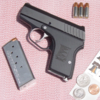I hear, "most small .380 ACP pistols are blowback operated," on a regular basis and I question it. It is almost into the category of "myths." As an example of .380 pistols, counting my 9mm Makarov, I have five [now six]. Of those, only the Makarov is blowback. I am not going to deny that there are blowback .380 pistols on the market. Of popular .380 pistols, both the Bersa and the High-Point are blowback. There, I am done, I have named all of the popular blowback .380 pistols. Yes, there is the PPK the Beretta Cougar family and a few extreme low-cost offerings. I think most can agree that those models are not hot sellers.
However, most modern .380 Pistols use some form of delayed blowback/locking breech mechanism. There is the entire Colt Government model family which includes, not surprisingly, the .380 Government model, the Mustang, Sig, Kimber, Springfield. Then there is the Glock 42, the Walther PK38, the Browning 1911-380 series, and Smith & Wesson Shield. There is the whole family of Kel-Tek derivatives. I can keep going, the point is, the, "most small .380 ACP pistols are blowback operated," is almost a myth.


